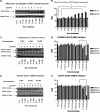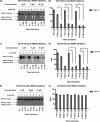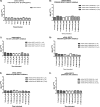Inhibitors of MAPK pathway ERK1/2 or p38 prevent the IL-1{beta}-induced up-regulation of SRP72 autoantigen in Jurkat cells
- PMID: 20729213
- PMCID: PMC2963399
- DOI: 10.1074/jbc.M110.121087
Inhibitors of MAPK pathway ERK1/2 or p38 prevent the IL-1{beta}-induced up-regulation of SRP72 autoantigen in Jurkat cells
Abstract
Phosphorylation is the most important post-translational event at a cellular level that is regulated by protein kinases. MAPK is a key player in the important cellular signaling pathway. It has been hypothesized that phosphorylation might have a role in the induction of break tolerance against some autoantigens such as SRP72. The aim of this study was to explore the pathways of phosphorylation and overexpression of the SRP72 polypeptide, using an in vitro model of Jurkat cells stimulated by recombinant human (rh)IL-1β in the presence of MAPK inhibitors. We used Jurkat cells as a substrate stimulated with rhIL-1β in the presence of MAPK inhibitors at different concentrations in a time course in vitro experiment by immunoprecipitation, immunoprecipitation-Western blotting, and real time PCR. Our results showed that rhIL-1β causes up-regulation of protein expression and phosphorylation of SRP72 in Jurkat cells. Inhibitors of the MAPK pathway ERK1/2 or p38α/β down-regulate the expression of SRP72 autoantigen in Jurkat cells stimulated by rhIL-1β. Our results highlight the importance of studying the pathways of activation and overexpression of autoantigens. It will be necessary to perform careful research on various kinases pathways, including MAPK in dermatomyositis and other rheumatic diseases, to help to explain the routes of activation and inhibition of autoantigens. The understanding of this process may help to develop new therapies to prevent and control the loss of tolerance toward own normal proteins.
Figures





Similar articles
-
Upregulation of RGS4 expression by IL-1beta in colonic smooth muscle is enhanced by ERK1/2 and p38 MAPK and inhibited by the PI3K/Akt/GSK3beta pathway.Am J Physiol Cell Physiol. 2009 Jun;296(6):C1310-20. doi: 10.1152/ajpcell.00573.2008. Epub 2009 Apr 15. Am J Physiol Cell Physiol. 2009. PMID: 19369446 Free PMC article.
-
Cell-specific activation profile of extracellular signal-regulated kinase 1/2, Jun N-terminal kinase, and p38 mitogen-activated protein kinases in asthmatic airways.J Allergy Clin Immunol. 2008 Apr;121(4):893-902.e2. doi: 10.1016/j.jaci.2008.02.004. J Allergy Clin Immunol. 2008. PMID: 18395552
-
Regulation of TNF mediated antiapoptotic signaling in human neutrophils: role of delta-PKC and ERK1/2.J Leukoc Biol. 2006 Dec;80(6):1512-21. doi: 10.1189/jlb.0406284. J Leukoc Biol. 2006. PMID: 17138860
-
Progress in the development of ERK1/2 inhibitors for treating cancer and other diseases.Adv Pharmacol. 2024;100:181-207. doi: 10.1016/bs.apha.2024.04.001. Epub 2024 Apr 24. Adv Pharmacol. 2024. PMID: 39034052 Review.
-
ERK1/2 and p38α/β signaling in tumor cell quiescence: opportunities to control dormant residual disease.Clin Cancer Res. 2011 Sep 15;17(18):5850-7. doi: 10.1158/1078-0432.CCR-10-2574. Epub 2011 Jun 14. Clin Cancer Res. 2011. PMID: 21673068 Free PMC article. Review.
Cited by
-
The Functional Roles of RNAs Cargoes Released by Neutrophil-Derived Exosomes in Dermatomyositis.Front Pharmacol. 2021 Sep 17;12:727901. doi: 10.3389/fphar.2021.727901. eCollection 2021. Front Pharmacol. 2021. PMID: 34603043 Free PMC article.
-
Kir2.1 Interaction with Stk38 Promotes Invasion and Metastasis of Human Gastric Cancer by Enhancing MEKK2-MEK1/2-ERK1/2 Signaling.Cancer Res. 2018 Jun 1;78(11):3041-3053. doi: 10.1158/0008-5472.CAN-17-3776. Epub 2018 Mar 16. Cancer Res. 2018. PMID: 29549164 Free PMC article.
-
Autoantibodies in the pathogenesis of idiopathic inflammatory myopathies: Does the endoplasmic reticulum stress response have a role?Front Immunol. 2022 Sep 15;13:940122. doi: 10.3389/fimmu.2022.940122. eCollection 2022. Front Immunol. 2022. PMID: 36189221 Free PMC article. Review.
-
Rough Titanium Oxide Coating Prepared by Micro-Arc Oxidation Causes Down-Regulation of hTERT Expression, Molecular Presentation, and Cytokine Secretion in Tumor Jurkat T Cells.Materials (Basel). 2018 Feb 28;11(3):360. doi: 10.3390/ma11030360. Materials (Basel). 2018. PMID: 29495627 Free PMC article.
-
Acute modulation of synaptic plasticity of pyramidal neurons by activin in adult hippocampus.Front Neural Circuits. 2014 Jun 2;8:56. doi: 10.3389/fncir.2014.00056. eCollection 2014. Front Neural Circuits. 2014. PMID: 24917791 Free PMC article.
References
-
- Bui N., Strub K. (1999) Biol. Chem. 380, 135–145 - PubMed
Publication types
MeSH terms
Substances
LinkOut - more resources
Full Text Sources
Miscellaneous

